The AMD Radeon R9 295X2 Review
by Ryan Smith on April 8, 2014 8:00 AM EST- Posted in
- GPUs
- AMD
- Radeon
- Radeon 200
Compute
Our final set of performance benchmarks is compute performance, which for dual-GPU cards is always a mixed bag. Unlike gaming where the somewhat genericized AFR process is applicable to most games, when it comes to compute the ability for a program to make good use of multiple GPUs lies solely in the hands of the program’s authors and the algorithms they use.
At the same time while we’re covering compute performance for completeness, the high price and unconventional cooling apparatus for the 295X2 is likely to deter most serious compute users.
In any case, our first compute benchmark is LuxMark2.0, the official benchmark of SmallLuxGPU 2.0. SmallLuxGPU is an OpenCL accelerated ray tracer that is part of the larger LuxRender suite. Ray tracing has become a stronghold for GPUs in recent years as ray tracing maps well to GPU pipelines, allowing artists to render scenes much more quickly than with CPUs alone.
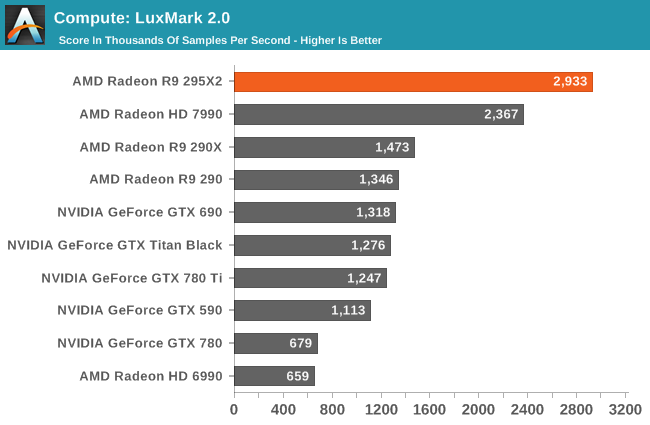
As one of the few compute tasks that’s generally multi-GPU friendly, ray tracing is going to be the best case scenario for compute performance for the 295X2. Under LuxMark AMD sees virtually perfect scaling, with the 295X2 nearly doubling the 290X’s performance under this benchmark. No other single card is currently capable of catching up to the 295X2 in this case.
Our second compute benchmark is Sony Vegas Pro 12, an OpenGL and OpenCL video editing and authoring package. Vegas can use GPUs in a few different ways, the primary uses being to accelerate the video effects and compositing process itself, and in the video encoding step. With video encoding being increasingly offloaded to dedicated DSPs these days we’re focusing on the editing and compositing process, rendering to a low CPU overhead format (XDCAM EX). This specific test comes from Sony, and measures how long it takes to render a video.
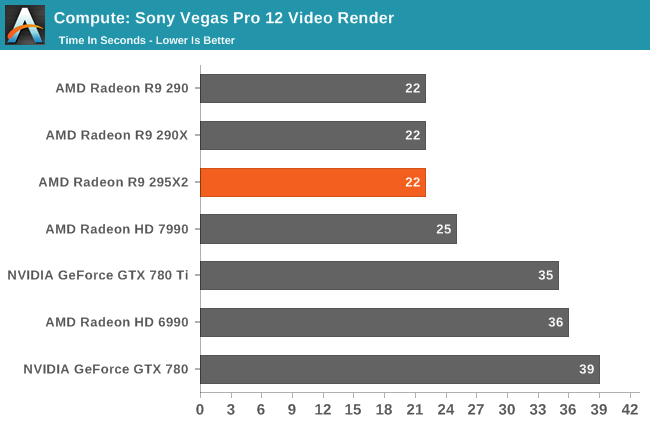
Sony Vegas Pro on the other hand sees no advantage from multiple GPUs. The 295X2 does just as well as the other Hawaii cards at 22 seconds, sharing the top of the chart, but the second GPU goes unused.
Our third benchmark set comes from CLBenchmark 1.1. CLBenchmark contains a number of subtests; we’re focusing on the most practical of them, the computer vision test and the fluid simulation test. The former being a useful proxy for computer imaging tasks where systems are required to parse images and identify features (e.g. humans), while fluid simulations are common in professional graphics work and games alike.
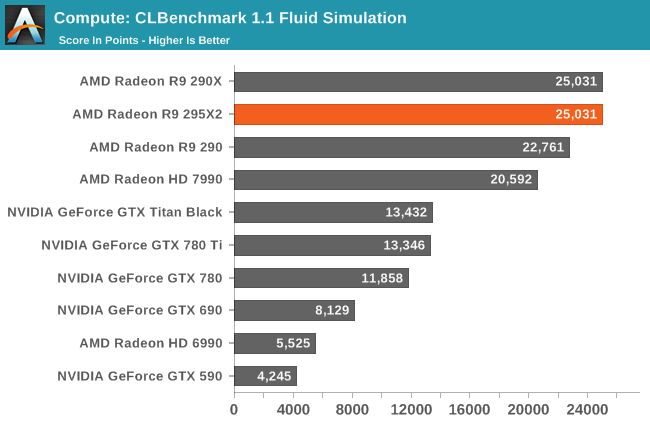

Like Vegas Pro, the CLBenchmark sub-tests we use here don't scale with additional GPUs. So the 295X2 can only match the performance of the 290X on these benchmarks.
Moving on, our fouth compute benchmark is FAHBench, the official Folding @ Home benchmark. Folding @ Home is the popular Stanford-backed research and distributed computing initiative that has work distributed to millions of volunteer computers over the internet, each of which is responsible for a tiny slice of a protein folding simulation. FAHBench can test both single precision and double precision floating point performance, with single precision being the most useful metric for most consumer cards due to their low double precision performance. Each precision has two modes, explicit and implicit, the difference being whether water atoms are included in the simulation, which adds quite a bit of work and overhead. This is another OpenCL test, as Folding @ Home has moved exclusively to OpenCL this year with FAHCore 17.
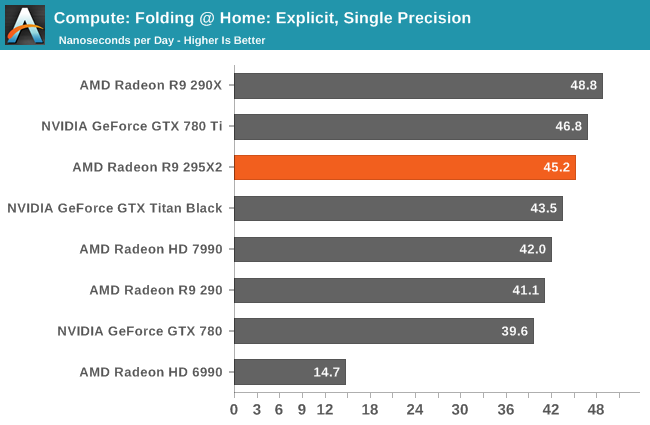
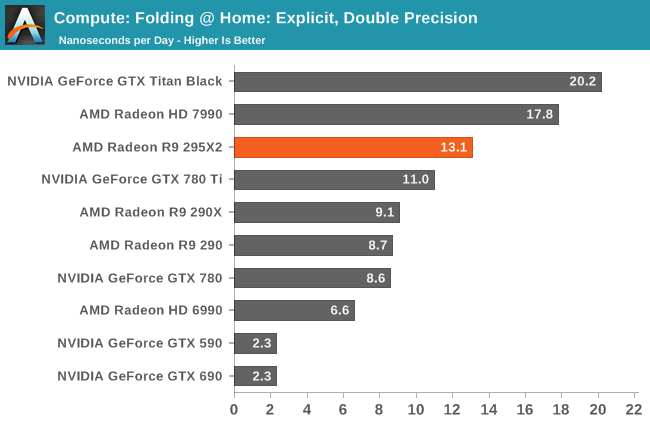
Unlike most of our compute benchmarks, Folding@Home does see some degree of multi-GPU scaling. However the outcome is really a mixed bag; single-precision performance ends up being a wash (if not a slight regression) while double-precision is seeing sub-50% scaling.
Wrapping things up, our final compute benchmark is an in-house project developed by our very own Dr. Ian Cutress. SystemCompute is our first C++ AMP benchmark, utilizing Microsoft’s simple C++ extensions to allow the easy use of GPU computing in C++ programs. SystemCompute in turn is a collection of benchmarks for several different fundamental compute algorithms, as described in this previous article, with the final score represented in points. DirectCompute is the compute backend for C++ AMP on Windows, so this forms our other DirectCompute test.
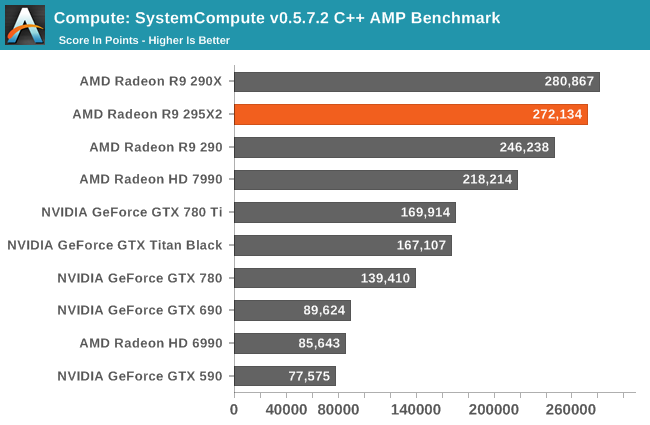
Our final compute benchmark has the 295X2 and 290X virtually tied once again, as this is another benchmark that doesn’t scale up with multiple GPUs.










131 Comments
View All Comments
extide - Tuesday, April 8, 2014 - link
Did you misread the article? They are simply comparing the frame pacing on the old stuff to the new stuff. Unfortunately, most people are too stupid to properly comprehend english, which is pretty damn sad if you ask me. Thus, a lot of people are either mistakenly thinking that this card has bad frame pacing, or that this review had anything to do with the frame pacing updates for GCN 1.0. NEITHER of those things are the case!JDG1980 - Tuesday, April 8, 2014 - link
These two different things really shouldn't have been in the same article. It's confusing, unfocused, and comes off as taking cheap shots at AMD over an old product. Let's be honest, there weren't many 7990s sold in the first place, and anyone who bought one for gaming and was disappointed with it could have resold it during the mining craze and at least broken even, if not actually turning a profit. A review of a new product isn't the best place to say "Old product X is still not perfect".srsbsns - Tuesday, April 8, 2014 - link
Are the Battlefield 4 benchmarks using mantle or directx?Ryan Smith - Tuesday, April 8, 2014 - link
Direct3D.Blitzninjasensei - Saturday, July 12, 2014 - link
Ryan, would you be able to do a comparison with Mantle as well as D3D? I would like to see how much the benefit is.iamkyle - Tuesday, April 8, 2014 - link
So...they're taking the Prescott approach to performance?"Bigger!!! Faster!!! Hotter!!!"
Sounds like some Core2 Duo-type innovation is needed by AMD here to get temps and power down to a reasonable level here.
Mondozai - Tuesday, April 8, 2014 - link
Temperatures are out of control?Can you even read a basic chart or is that too much for your tiny little head to handle?
Da W - Tuesday, April 8, 2014 - link
Great EVGA GTX 780 superclocked to sell!Reason: bought too soon, i want this dual GPU bitch!
TheinsanegamerN - Friday, April 11, 2014 - link
I'll buy it. my 550ti is getting a little long in the toothMondozai - Tuesday, April 8, 2014 - link
Basically, for a few hundred dollars you are paying a premium on noise and GPU load compared to 2 R9-290X in Crossfire.While this card has a frame pacing improvement that is massive compared to 7990, it still trails 780 Ti in SLI. Although the 780 Ti is painfully gimped on 4K resolutions due to VRAM bottlenecks.
Maxwell's high-end cards in SLI is going to be beastly, since Nvidia is finally going to resolve the VRAM issue.